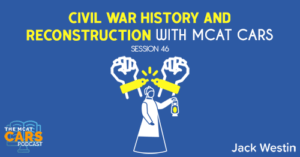Apple Podcasts | Google Podcasts

Session 46
Let’s apply MCAT CARS reading skills to a critical analysis of American history. Also, how to keep track of key points in complex passages!
As always, we’re joined by Jack Westin, the leader in MCAT CARS prep. Also, check out The Premed Years for more resources and information you need to know to help you get into medical school.
Listen to this podcast episode with the player above, or keep reading for the highlights and takeaway points.
[01:47] A Brief Overview About the Article
This is an article about History and a lot of students don’t normally like history passages. It’s because it’s so hard to find the author’s points of view. The structure is very straightforward.
The problem students may face with today’s article is understanding what the author is trying to say after mentioning something. It’s not going to be clear until later on what the author really wants to explain or convey.
Link to article:
Conservatives sometimes accuse the academic left of ignoring the good in U.S. history and emphasizing the horrors. But in some respects, the typical telling of the American story does not focus enough on the horrors.
As I recall from my distant youth, U.S. history texts dealt with the run-up to the Civil War, then the war itself, then the failure of Reconstruction, before moving on to the Gilded Age and progressive reform. But the failure of Reconstruction was not just a disembodied fact but also a planned and ruthless act of sabotage. As Henry Louis Gates Jr.’s new book, “Stony the Road: Reconstruction, White Supremacy, and the Rise of Jim Crow,” effectively reminds us, the period of history following the Civil War involved a violent campaign to reverse the social, political and economic outcomes of the conflict. And this effort — which southerners called “Redemption” — was successful in almost every respect.
With the defeat of the Confederacy, the federal government’s enforcement of civil and voting rights was beginning to work a revolution. Hundreds of thousands of African American citizens registered to vote and eventually elected an estimated 2,000 black officials at every level of government. The Freedmen’s Bureau helped former slaves in matters ranging from land rights to education. Families divided by slavery were reunited. Workers transitioned into a wage system. The process was difficult but hopeful.
The white South, however, was having none of it. A broad counterattack was mounted to undo the work of the 13th, 14th and 15th amendments. This involved a campaign of murder and intimidation to disenfranchise black Republicans and the imposition of economic systems (sharecropping and convict labor) that effectively re- created the conditions of slavery. By 1875 — just a decade after the war ended — white rule was reestablished in all but three southern states. At first, Republicans such as President Ulysses S. Grant tried to help southern blacks through armed interventions by federal troops. But this policy proved politically unpopular and was abandoned.
The re-imposition of white rule was a bloody, unpunished historical crime. “The depth of the reaction against the demands that the Negro have the right to vote,” Gates argues, “and the sheer range of racist vehemence and terrorism that arose to neutralize that right . . . is stunning to contemplate.” Between 1868 and 1871, an estimated 400 African Americans were lynched across the South. About 30 were executed on a single day in Meridian, Miss. The killers — often roving bands of former Confederate soldiers — acted with total impunity. By 1890, Ben Tillman, who would serve as governor of South Carolina, was crowing: “The triumph of Democracy and white supremacy over mongrelism and anarchy is most complete.”
[03:23] Paragraph 1, Sentence 1
Conservatives sometimes accuse the academic left of ignoring the good in U.S. history and emphasizing the horrors.
Jack says:
You should be able to know the general history of America. You should know about the revolution and when that happened. Keep a date in mind for the revolution. 1776 is what most people think.
You should also know about the civil war in the 1860’s and the reconstruction right after it in the 1860s. Know a little bit about World War I, World War II, the Great Depression, and the Cold War.
Those are basic things that the MCAT does ask about or present passages on. So at least know that the American Revolution was between England and America. Just figure out the basics of these wars because these moments really impacted America today.
Most of these articles are going to be based on America because this is an American test. The organization that runs the MCAT is in Washington, D.C. So it helps to know some history on America.
In terms of conservative vs. liberal, you should know about basic stuff. You can use anything to learn this as this is basic politics of America. They don’t ask questions about the political nature of Britain or another country.
'Because the passages are so Americanized, it doesn't hurt to have some kind of background knowledge on this.'Click To TweetIt will make you less intimidated by this topic and by the discussion. You will probably be more interested in what you’re reading if you have some idea of what’s going on.
If you have trouble with certain types of passages – political, religious, etc – do some more of them. This way, you start getting acclimated to what they’re discussing, the topics, and the nature of it. It doesn’t hurt to know a little about America.
Back to this particular sentence, it’s talking about how conservatives use these left-wing liberal people of emphasizing the horrors and the problems of America.
[08:25] Paragraph 1, Sentence 2
But in some respects, the typical telling of the American story does not focus enough on the horrors.
Jack says:
You would think the author is probably going to say this is bad, so we shouldn’t be talking about the horrors. But there’s a twist and the author wants to talk more about the horrors.
[09:30] Paragraph 2, Sentence 1
As I recall from my distant youth, U.S. history texts dealt with the run-up to the Civil War, then the war itself, then the failure of Reconstruction, before moving on to the Gilded Age and progressive reform.
Jack says:
The author is recalling his youth and what he read in U.S. History textbooks about everything that happened in the Civil War and after. It does state the failure of reconstruction which is something you can understand and educate yourself on. Although you don’t need to know whether reconstruction is a success or failure but the author has teased it as a failure.
[10:15] Paragraph 2, Sentence 2
But the failure of Reconstruction was not just a disembodied fact but also a planned and ruthless act of sabotage.
Jack says:
The author is saying this is deliberative sabotage. We don’t have the context right now. And we don’t know the direction the author is headed to in this conversation. We should still keep track of it and understand where the author is headed with this whole argument.
[11:00] Paragraph 2, Sentence 3
Henry Louis Gates Jr.’s new book, “Stony the Road: Reconstruction, White Supremacy, and the Rise of Jim Crow,” effectively reminds us, the period of history following the Civil War involved a violent campaign to reverse the social, political and economic outcomes of the conflict.
Jack says:
A book author is mentioned here and the author is saying there’s a lot of push to reverse the outcome of the war and what it’s trying to accomplish. You don’t necessarily need to know the exact outcome of the war or why they went.
If you took any history class in high school, you would know the Civil War is all about slavery. The whole conflict was whether or not there should be slavery. But you don’t need to know that at this point as long as you know there were some conflict with the Civil War. And there was a group that was trying to reverse this outcome but the campaign seems to be violent.
[12:26] Paragraph 2, Sentence 4
And this effort — which southerners called “Redemption” — was successful in almost every respect.
Jack says:
This is why Reconstruction failed because Redemption was effective. They were trying to redeem themselves and have some kind of revenge. That was successful and that’s the sabotage which was what led the Reconstruction’s failure.
[13:12] Paragraph 3, Sentence 1
With the defeat of the Confederacy, the federal government’s enforcement of civil and voting rights was beginning to work a revolution.
Jack says:
This is a jump as we went from talking about from Reconstruction, failure, and sabotage to how this is the end of the war and this is what’s happening. The author is backtracking without actually telling you that. They’re going back into time.
Passages sometimes say something and they’ll go back to an earlier time to develop their point of view. So you need to be able to catch on to these things.
[15:04] Paragraph 3, Sentence 2
Hundreds of thousands of African American citizens registered to vote and eventually elected an estimated 2,000 black officials at every level of government.
Jack says:
The author is explaining the Revolution now and the voting rights led to this change and who’s leading the government because all the African-Americans were allowed to vote. We’re going back to history and learning about what happened after the war.
[15:36] Paragraph 3, Sentence 3
The Freedmen’s Bureau helped former slaves in matters ranging from land rights to education.
Jack says:
Try to understand this although this is not necessarily a point that they’re going to ask questions about. But it’s establishing the history. If you didn’t take history in high school or you’re an international student, you don’t need to take Civil War. They’re explaining it to you right now.
[16:25] Paragraph 3, Sentence 4
Families divided by slavery were reunited.
Jack says:
It’s just going through the process of post war.
[16:33] Paragraph 3, Sentence 5
Workers transitioned into a wage system.
Jack says:
The former slaves are getting paid.
[16:40] Paragraph 3, Sentence 6
The process was difficult but hopeful.
Jack says:
It’s a long process getting people to vote, connecting families, educating them, giving them land and money. It seems like the Reconstruction was working here. However, you shouldn’t hold your breath as they may talk about how it’s going to fail.
A lot of students go in thinking they’re going to have to read the passage on a hundred things. But usually, these passages focus on one thing and they go into detail on it. Don’t be overwhelmed. You’re only focused on the Civil War and Reconstruction at this point.
[17:35] Paragraph 4, Sentence 1
The white South, however, was having none of it.
Jack says:
We could assume the South was the Confederacy. They were the ones defeated. They were not having none of it, which means they didn’t like this stuff. They didn’t like how Blacks are getting voting rights, power, and land usage.
[18:07] Paragraph 4, Sentence 2
A broad counterattack was mounted to undo the work of the 13th, 14th and 15th amendments.
Jack says:
This sounds like sabotage which goes back to the second paragraph again.
[18:35] Paragraph 4, Sentence 3
This involved a campaign of murder and intimidation to disenfranchise black Republicans and the imposition of economic systems (sharecropping and convict labor) that effectively re- created the conditions of slavery.
Jack says:
It’s explaining what they were doing in their counterattacks.
[18:57] Paragraph 4, Sentence 4
By 1875 — just a decade after the war ended — white rule was reestablished in all but three southern states.
Jack says:
It’s saying how they were successful in their sabotage.
[19:11] Paragraph 4, Sentence 5
At first, Republicans such as President Ulysses S. Grant tried to help southern blacks through armed interventions by federal troops.
Jack says:
It shows that even the president was trying to help prevent the sabotage.
[19:32] Paragraph 4, Sentence 6
But this policy proved politically unpopular and was abandoned.
Jack says:
Unfortunately, the president probably thought he would lose too many votes so he’d rather not do it.
This paragraph basically highlights what the sabotage was to potentially cause the failure of Reconstruction. This goes with the first paragraph. obviously, the author does not like how Reconstruction was a failure and how it was sabotaged.
It’s the author’s point of view at this point. And we can deduce this because the author says this is a horror.
[20:24] Paragraph 5, Sentence 1
The re-imposition of white rule was a bloody, unpunished historical crime.
Jack says:
This is where you’re getting the author’s opinion of these horrors. We need to be talking more about them because it was unpunished.
Most students give up halfway through this passage. Usually, you can find the main idea in the middle of the passage or near the end. But if you’re too intimidated by the first couple of paragraphs, you’re not going to read the rest like a normal person. You’re going to be in your head psyching yourself out.
'The first two paragraphs are going to be the make it or break it for most students.'Click To TweetIf you can get through the first two paragraphs, you’re going to understand a lot going into the last stages of the passage.
[21:33] Paragraph 5, Sentence 2
“The depth of the reaction against the demands that the Negro have the right to vote,” Gates argues, “and the sheer range of racist vehemence and terrorism that arose to neutralize that right . . . is stunning to contemplate.”
Jack says:
It just shows that a lot of bad things happened. It goes back to Gates’ book that was mentioned in the second paragraph.
[22:05] Paragraph 5, Sentences 3-4
Between 1868 and 1871, an estimated 400 African Americans were lynched across the South. About 30 were executed on a single day in Meridian, Miss.
Jack says:
It’s showing the impact of the horrors.
[22:27] Paragraph 5, Sentence 5
The killers — often roving bands of former Confederate soldiers — acted with total impunity.
Jack says:
Impunity sounds like immunity and it also has that punishment through “pun” so it means immune from punishment. You’re not going to get punished. And this goes along the same lines as “unpunished historical crime.”
[23:12] Paragraph 5, Sentence 6
By 1890, Ben Tillman, who would serve as governor of South Carolina, was crowing: “The triumph of Democracy and white supremacy over mongrelism and anarchy is most complete.”
Jack says:
This is going along the lines of doing the stuff they want. They’re trying to reclaim their supremacy. You don’t have to know the exact meaning of that quote and you don’t need to know who Tillman was. But you know it’s going along the lines of sabotage and how they’re ruining or hurting the chances of Reconstruction.
The big picture of the entire passage here is that the author is trying to tell us that the Reconstruction was a failure because of sabotage. And that is the horror the author was talking about.
Links:
Link to article:
SEARCH SITE
SEARCH SITE
LISTEN FOR FREE











